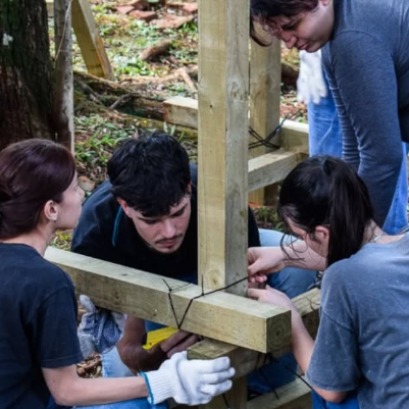
Missions | New illegal felling in the Piñalito Provincial Park in San Pedro reveals the silent expansion of deforestation in protected areas
The advance of deforestation on protected areas was once again evident this week in the Piñalito Sur Provincial Park, in San Pedro, where the Ministry of Ecology and Renewable Natural Resources confirmed a new case of selective illegal logging. The event occurs in a context of growing concern about the fragility of the environmental control system in rural and border areas, where the scarcity of resources, personnel and logistics limits the capacity of surveillance against criminal organizations organized to steal native woods and market them on the black market in connivance with sawmill owners.
The provincial park, located on National Route 14 at the southern access and about 50 kilometers from Bernardo de Irigoyen, was already under investigation for another wood theft detected in January of this year, which involved local sawmill owners. Now, a new episode once again compromises the security of the protected area. According to the official statement, Ecologys intervention was activated after an investigation that would have detected suspicious movements inside the park. Through an on-site inspection, technicians identified sectors with evidence of selective extraction of native species. However, the agency did not specify which species were felled. For the park rangers and residents of the area, however, the damage was already done. Sources consulted warned that, due to the type of trees felled and the estimated volume - more than 20 rolls of hard and valuable species - the operation would have required two or three days of work, at least three trucks, personnel to turn the specimens, chainsaws, prior planning for the selection of the extracted specimens and favorable weather conditions. There is an entire organization behind this. And no one heard anything or saw anything in the area, when a felling of this type does not go unnoticed. If there were real surveillance and sufficient resources as Ecology says, these environmental crimes could be prevented, they pointed out. The contrast between the magnitude of the crime due to the damage involved in felling trees in a provincial park and the official reaction fueled questions on social networks and groups of park rangers, who denounce that they face a context of job insecurity, lack of fuel, vehicles and equipment, as well as the impossibility of carrying out effective patrols in border areas. “We register trees already felled, but never responsible,” they lament. They maintain that festive times, such as those approaching the end of the year, are when criminals take the most advantage because they understand that they are “liberated zones” due to the lightness of the controls and operations of patrols and rakes in the jungle. A modality that is difficult to detect, but possible to prevent Selective illegal extraction is when the criminal carries out felling only the trees of greatest commercial value without creating visible gaps in the forest, which which makes its detection difficult using satellite images. However, specialists emphasize that sustained territorial inspection, combined with forest traffic controls and real traceability of wood, would allow these practices to be stopped. The questions are then repeated: How do loaded trucks manage to leave a provincial park without being detected? How does this wood enter the commercial circuit without digital forest guides? Who controls the raw material that enters the sawmills of San Pedro, Irigoyen, San Vicente, El Soberbio? Is there complicity in the chain of control? The affected site is located next to a private property that already registers two active cases for similar events, which increases suspicions about the operation of networks for the collection and smuggling of native wood. An area of very high ecological value under threat The alerts of those who know the environmental value of the Piñalito Provincial Park are on, with 3,800 hectares, it is one of the enclaves with the highest ecological value in the Paranaense Forest. The protected area is Classified as Red Category in territorial planning, it is an intangible area where the extraction of native forest is totally prohibited. The park constitutes a key biodiversity corridor, hosts research on threatened species - such as the red carayá monkey, at critical risk globally - and connects with other public and private reserves in the region. Despite its importance, the area has only one park ranger post and three agents assigned in rotation. In January of this year, another case of selective logging led to an internal investigation and the transfer of post personnel, although the result of the summary was never publicly reported. Formal complaint and persistent doubts After this new discovery, Ecology filed a complaint with the Environmental Defense Directorate of the Misiones Police and initiated a file for violation of the Protected Natural Areas (XVI-No. 29) and Forests (XVI-No. 105) laws. However, environmental organizations and local residents question the effectiveness of the operations. Last week, the ministry itself had reported on preventive overflights over protected natural areas in the Yabotí Biosphere Reserve and "they did not detect anything irregular." A few days later, the felling was confirmed.For specialists, the case exposes a structural problem:• • a control system without sufficient resources,• • reactive rather than preventive operations,• • lack of real traceability of the native wood transported,• • and possible collusion in the extraction and transportation chain• • We are dealing with organized criminals, with logistics and knowledge of the terrain, and support from competent authorities. Without continuous territorial presence and without coordinated security forces, the jungle remains defenseless, sources in the sector highlight. • While thefts are repeated and public resources are consumed in ineffective operations, the pressure on one of the last refuges of the Misiones Jungle grows without restraint and puts the future of the protected ecosystems of Misiones at risk.
IT MAY INTEREST YOU
 The second largest wetland in South America is located in Argentina: what is it?
The second largest wetland in South America is located in Argentina: what is it?
Argentina has national parks that place it in a unique position within South America, competing with 300 others. Which is the largest? South America is home to more than 300 national parks, but many go unnoticed. There are extensive wetlands that have been the subject of major ecological restoration projects, to coastal mountains with deep indigenous heritage. Today we tell you the case of one located in Argentina.
 Botanists discover giant trees up to 3,��� years old in Tanzania, unknown until now by science
Botanists discover giant trees up to 3,��� years old in Tanzania, unknown until now by science
Scientists have identified a new species of giant tree, Tessmannia princeps, in the Udzungwa Mountains. This species had never before been recorded by science.
 Architecture with identity: university students from Argentina and Paraguay design and build with missionary wood
Architecture with identity: university students from Argentina and Paraguay design and build with missionary wood
The Faculty of Art and Design (FAyD) of the National University of Misiones (UNaM) hosted the inauguration of the first edition of “Yvyvyrá: territory, matter and architecture”, an international workshop that promotes learning, experimentation and architectural design using wood and other materials typical of the biomes of the Atlantic Forest (Paranaense Forest) and the Humid Chaco.





















